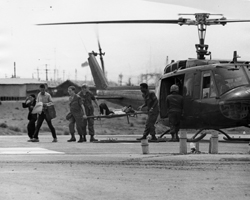So Others May Live: Dustoff - Medical Evacuation in the Vietnam War


Unloading patients from medevac helicopter at 91st Evacuation Hospital Emergency room
(James Evans Collection [VA042547])
The Vietnam War posed a unique logistical challenge to military leaders. The war was fought in triple canopy jungle terrain and bad weather, there were constant guerilla attacks and the front line changed from day to day. Often vehicles traveling on the roads were subject to landmines, ambushes and poor road conditions, and some of the areas where heavy fighting took place were so remote there were no roads. All of these factors posed one major problem for the military. How do they transport the wounded safely and in a timely manner to aid stations and hospitals for proper medical care? The Army’s medical branch decided to revisit an idea that came about in the Korean War - a helicopter ambulance corps.
During the Korean War, the military had similar road and accessibility issues, which made traditional truck ambulances a poor method for transporting wounded. They began to experiment with using helicopters instead. In Vietnam this idea was perfected to such a point that helicopter and air ambulances became an icon of the war itself. In most cases a wounded soldier would be in a hospital receiving medical care within 35 minutes of being wounded. As a matter of fact, the mortality rate of wounded soldiers who made it to medical treatment was 2.6 percent as compared to 4.5 percent from World War II. Soldiers knew that if they were wounded they had a better chance of surviving and quickly receiving medical care than in any other war that the United States had previously participated in, a fact that did much to boost troop morale.
We would see patients so much more quickly than had ever happened before in war zone where you couldn’t depend on ambulance runs through rotten roads and muddy hills.
- Michael Mittelmann, Orthopedic Surgeon in the 8th Field Hospital in Nha Trang [Oral History #OH0172], Transcript page 11, lines 18-20.
(listen; read part 1; read part 2; more information)
Vietnam Center & Sam Johnson Vietnam Archive
-
Address
Texas Tech University, Box 41041, Lubbock, TX 79409 -
Phone
(806)742-9010 -
Email
vnca@ttu.edu
